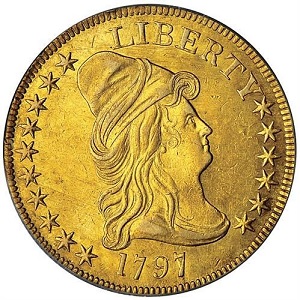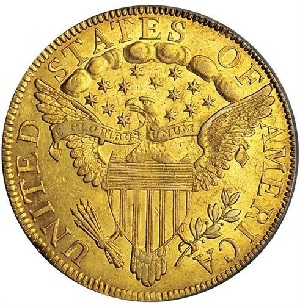1797 Capped Bust Large Eagle $10 Eagle
The earliest United States silver and gold coins featured an eagle on the reverse, widely ridiculed as a scrawny, weakling bird. Mint officials were concerned about the image of the nation conveyed oversees by United States coinage. A search began to find a more powerful emblem, one that would engender respect in the Old World.(1)
The Great Seal of the United States was finally chosen to grace the reverse. The Great Seal had been officially sanctioned in 1782 for display on diplomatic documents, but now it was employed to elevate the image of the United States, through its coinage, to one suggestive of power and strength. Chief Engraver Robert Scot adapted the Great Seal to the nation’s coins.
In many numismatic references, the regal bird element is named the “Heraldic Eagle” reverse. Many others simply call it the “Large Eagle” reverse.
In mid-1797, Capped Bust $10 eagles featuring the large eagle reverse commenced production, switching over from the small eagle design. Mint records suggest a production of 10,940 for the 1797 Large Eagle, but detailed studies of die states and emission sequences propose a broader range of 8,750 to 12,500 pieces struck.(2)
Experts estimate today a survivorship of 250 examples of the 1797 Capped Bust Large Eagle.(3)
There are three die varieties, distinguished by the shape of the eagle's neck and the position of the star to the left of the beak. The BD-3 die variety is the least encountered of the three.(4)
As one might expect for an early U.S. gold coin with historical significance, long-term price trends for the 1797 Capped Bust Large Eagle $10 have been steadily strong. There is no reason to believe this pattern will not continue far into the future.
| Estimated survivors in all grades: 250 ?
The survivor estimate from PCGS represents an average of one or more experts' opinions as to how many examples survive of a particular coin in all grades. Survival estimates include coins that are raw, certified by PCGS, and certified by other grading services. Learn more at PCGS. |
| PCGS Rarity Scale: 6.6 ?
The 'PCGS CoinFacts Rarity Scale' assesses the relative rarity of all U.S. coins, based on estimated surviving examples. The scale runs from 1.0 to 10.0. The higher the number, the rarer the coin.
Learn more at PCGS. |
| Click HERE to check for availability on eBay** |
Preview of eBay selection (If no 1797 Large Eagle 10's below, be sure to hit HERE link above):
 |
 |
| Trendline Avg = 17.23 | GOOD |
Historic Value Trend Charts:
| Last updated 9-6-24 | Return to Key Date Coin List | |
| Compare to Common Date Coin of Same Type | ||
|
|
||
| Download Charts to Your Computer | ||
Sources
1. Garofalo, Michael: "America's First Gold Eagles: Part II". Greysheet, May 26, 2021.
2. Stack's Bowers Galleries. 1797 Capped Bust Right Eagle. Heraldic Eagle. Nov 2022 Auction.
3. PCGS. 1797 $10 Large Eagle (Regular Strike).
4. Heritage Auctions. 1797 $10 Large Eagle, BD-2. May 2022 Auction.
**Many very fine coin dealers sell on eBay. At any point in time, there may be over one million search results for United States coins. This includes quite a few of the recommendations on our Key Date Coin List.
If you’re thinking about purchasing a rare coin, eBay is certainly worth a look. For your convenience, the links from this site to eBay are coded to bring up only coins certified by PCGS and NGC.
As is always, always the case, never buy a valuable coin from a seller whose trustworthiness cannot be verified. Learn more about this at our chapter Best Places to Buy Coins, which also has a section on doing business on eBay.
In the interest of full disclosure, Rare Coins 101 receives a small commission anytime someone connects to eBay from this site and purchases something.
Coin images by Stack's Bowers Galleries.


